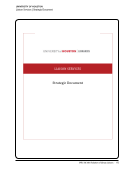SPEC Kit 349: Evolution of Library Liaisons · 97
People. Time. Money.
Providing high quality resources with stressed budgets. Time management of liaisons’ competing responsibilities.
Finding the best ways to communicate with faculty in other colleges.
Recruitment and retention of qualified staff. Insuring that institutional service standards are met. Achievement of
successful engagements with academic departments.
Reframing the role of the liaison to academic departments. Faculty who insist on print rather than e-books. Liaisons
must be able to build relationships and have to get out of the library and into the departments.
Relationship building and true collaboration is hard and time-consuming. Lack of agreement among liaison librarians of
the value of the work. Work is amorphous and ambiguous and relies on opportunity and individual relationships.
Requires continuous effort to engage with changing populations with a variety of communication preferences. Faculty
clients, particularly, are very busy with many demands on their time. Building and maintaining necessary skill sets
in a time of rapid change (technology, data science &management, etc.) Determining appropriate quantitative and
qualitative measure of liaison’s activity and outcomes.
Resistance to change in duties from library liaisons. Reaching departments that are not overly-receptive to
liaison services.
Responsiveness of departments. Breadth and depth of possible engagements (both in terms of topics and
methods). Time.
Scalability. Balancing workload. Buy in from librarians too embedded in departments.
Scalability and resource allocations. How do we measure success and outcomes. Communications from and to liaisons.
Size of departments/colleges assigned to just one liaison. Sustainability of services/availability given the liaison-to-
student or faculty member ratio. Balancing outward-focused liaison services with the work of the organization/projects/
initiatives.
Some departments aren’t very responsive, and many faculty do not consider it essential. We can’t serve everyone—
sometimes we have more demand than we can meet. We have both funding and staffing issues. It is difficult to
coordinate liaison services across subject areas.
Some departments more communicative than others about their needs.
Some liaisons are more engaged than others. Using liaisons to communicate with faculty can result in uneven
distribution of information. Keeping liaisons abreast of trends in new areas: data management, scholarly
communications, demand driven acquisitions, etc.
Some liaisons need more training to learn how to provide user-based services. The workload of liaisons is increasingly
heavy not enough time to do all of the work. Paradigm shift is necessary to focus more on what users want and less on
what librarians do.
Sufficient time/staff to be as creative and responsive as we would like. Sufficient time to develop expertise in multiple
disciplines. Perception by some academic departments that they are self-sufficient.
The changing research and publishing landscape requires new skills and attitudes that not all liaisons currently have.
Faculty do not understand what libraries do and are confused about liaison roles and services. The problem of liaisons
focusing on what they do rather than on the impacts they make.
People. Time. Money.
Providing high quality resources with stressed budgets. Time management of liaisons’ competing responsibilities.
Finding the best ways to communicate with faculty in other colleges.
Recruitment and retention of qualified staff. Insuring that institutional service standards are met. Achievement of
successful engagements with academic departments.
Reframing the role of the liaison to academic departments. Faculty who insist on print rather than e-books. Liaisons
must be able to build relationships and have to get out of the library and into the departments.
Relationship building and true collaboration is hard and time-consuming. Lack of agreement among liaison librarians of
the value of the work. Work is amorphous and ambiguous and relies on opportunity and individual relationships.
Requires continuous effort to engage with changing populations with a variety of communication preferences. Faculty
clients, particularly, are very busy with many demands on their time. Building and maintaining necessary skill sets
in a time of rapid change (technology, data science &management, etc.) Determining appropriate quantitative and
qualitative measure of liaison’s activity and outcomes.
Resistance to change in duties from library liaisons. Reaching departments that are not overly-receptive to
liaison services.
Responsiveness of departments. Breadth and depth of possible engagements (both in terms of topics and
methods). Time.
Scalability. Balancing workload. Buy in from librarians too embedded in departments.
Scalability and resource allocations. How do we measure success and outcomes. Communications from and to liaisons.
Size of departments/colleges assigned to just one liaison. Sustainability of services/availability given the liaison-to-
student or faculty member ratio. Balancing outward-focused liaison services with the work of the organization/projects/
initiatives.
Some departments aren’t very responsive, and many faculty do not consider it essential. We can’t serve everyone—
sometimes we have more demand than we can meet. We have both funding and staffing issues. It is difficult to
coordinate liaison services across subject areas.
Some departments more communicative than others about their needs.
Some liaisons are more engaged than others. Using liaisons to communicate with faculty can result in uneven
distribution of information. Keeping liaisons abreast of trends in new areas: data management, scholarly
communications, demand driven acquisitions, etc.
Some liaisons need more training to learn how to provide user-based services. The workload of liaisons is increasingly
heavy not enough time to do all of the work. Paradigm shift is necessary to focus more on what users want and less on
what librarians do.
Sufficient time/staff to be as creative and responsive as we would like. Sufficient time to develop expertise in multiple
disciplines. Perception by some academic departments that they are self-sufficient.
The changing research and publishing landscape requires new skills and attitudes that not all liaisons currently have.
Faculty do not understand what libraries do and are confused about liaison roles and services. The problem of liaisons
focusing on what they do rather than on the impacts they make.












































































































































































































